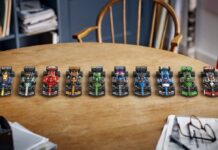One of the most important people at the rally on December 14 was neither a politician nor an Amazon employee. Running operations behind the scenes alongside workers was a 23-year-old college student named Nimo Omar, who also helped cofound the Awood Center. The American-born daughter of East African refugees, Omar stands 5’ 1″. A devout Muslim, she wears a headscarf, black plastic-framed glasses, and a slender hoop in her nose. She speaks four languages—English, Somali, Oromo, and Amharic—and her favorite expression of approval is “dope.” At the Awood Center, people affectionately call her “the lioness.”
In the early 1990s, in the midst of the Somali Civil War, Omar’s parents, who had fled to Kenya as refugees, emigrated to Atlanta, Georgia. Not long afterward, the couple split up, and Omar’s teenaged mother found herself isolated with two small children in a sprawling Southern city with few Somalis. “She didn’t know English and had never driven across the country,” Omar says. “But she knew she had relatives in Minnesota.” So she bundled Omar and Omar’s older brother into their car seats for the 16-hour road trip north.
Somali refugees had been clustering in the Twin Cities since the ’90s, with each new migrant reinforcing the attraction for the next. Eventually, some 52,000 people who live in Minnesota would report Somali ancestry, the largest population in the US.
Omar’s family moved in with a cousin in Rochester, a city about an hour and a half south of Minneapolis. Omar’s father, meanwhile, began spending much of his time back in East Africa, eventually remarrying there. So in 2006, Omar and her brother temporarily moved to join him in an ethnically Somali region of Ethiopia.
Those years in Africa made Omar conscious of how many advantages she had relative to other Somalis. “I was a 10-year-old girl who grew up in this privileged country,” she says. During one trip, a relative who had recently given birth visited Omar’s father’s house, then lost the newborn to preventable illness; Omar watched her grief-stricken family wash the infant’s body, preparing it for a funeral. When she was 15, not long before she moved back to the US, Omar and her brother were detained by Ethiopian immigration agents who claimed they owed $3,000 in fees. Omar spent three nights sleeping on the concrete floor of a jail cell, sharing the space with around seven Somali women who’d been trying to make their way to France. What stuck with Omar, once her family had raised enough money to free her, was the women: how they’d told her about surviving without food or water in a series of detention centers, how curious they were about America—and again, how much privilege she had relative to them.
Life back in the States, meanwhile, would make her conscious of how little privilege she had relative to other Americans. By the time Omar returned, her mother had relocated to Las Vegas. There, Omar was the only girl who wore the hijab in her high school. White boys taunted her, threatened to trip her on the stairs, called her a terrorist, and asked her what she thought of Osama bin Laden. She remembers thinking, “I’m not a part of the fabric of this country.”
Omar was alienated but ambitious. During her senior year of high school, she moved back to Minneapolis, where she later enrolled in community college; by her sophomore year of college, she’d been elected president of the student senate. She also began getting involved with Black Lives Matter—just in time for the protest movement to swing its attention to the Twin Cities.
On November 15, 2015, police in Minneapolis shot and killed Jamar Clark, 24, an unarmed black man, after responding to a domestic violence call. Many witnesses claimed that Clark was already handcuffed when police shot him in the head. Police denied it and said he’d engaged them in a scuffle, during which Clark allegedly reached for one officer’s gun. Local Black Lives Matter activists took to social media, organizing a march to the city’s Fourth Precinct police station under the hashtag #justiceforjamar, which evolved into an open-ended occupation of the street outside the precinct, with tents and banners stretching down the block. Omar settled in for the long haul.







